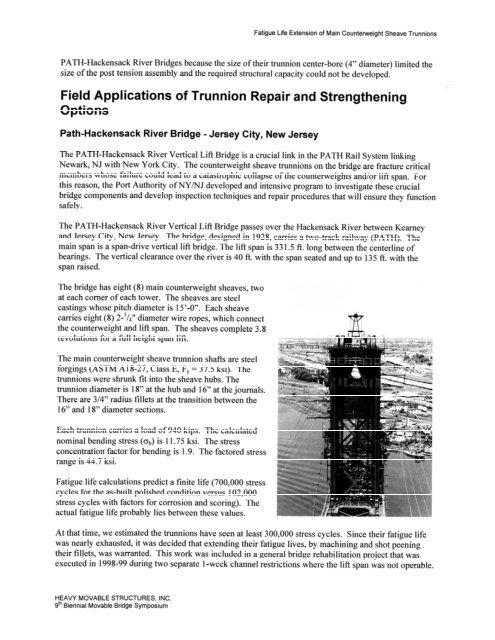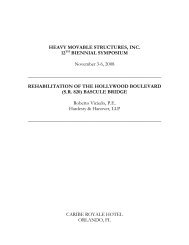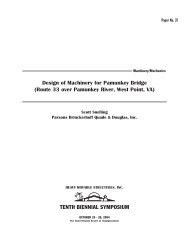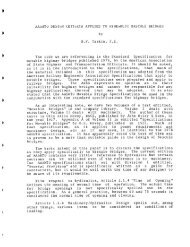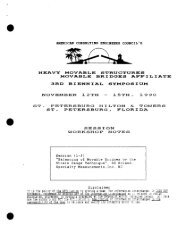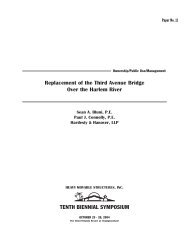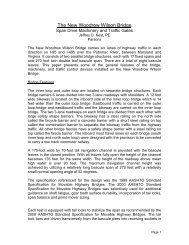Fatigue of Counterweight Sheave Trunnions - Heavy Movable ...
Fatigue of Counterweight Sheave Trunnions - Heavy Movable ...
Fatigue of Counterweight Sheave Trunnions - Heavy Movable ...
You also want an ePaper? Increase the reach of your titles
YUMPU automatically turns print PDFs into web optimized ePapers that Google loves.
<strong>Fatigue</strong> Life Extension <strong>of</strong> Main <strong>Counterweight</strong> <strong>Sheave</strong> <strong>Trunnions</strong><br />
PATH-Hackensack River Bridges because the size <strong>of</strong> their trunnion center-bore (4" diameter) limited the<br />
size <strong>of</strong> the post tension assembly and the required structural capacity could not be developed.<br />
Field Applications <strong>of</strong> Trunnion Repair and Strengthening<br />
Options<br />
Path-Hackensack River Bridge - Jersey City, New Jersey<br />
The PATH-Hackensack River Vertical Lift Bridge is a crucial link in the PATH Rail System linking<br />
Newark, NJ with New York City. The counterweight sheave trunnions on the bridge are fracture critical<br />
members whose failure could lead to a catastrophic collapse <strong>of</strong> the counterweights and/or lift span. For<br />
this reason, the Port Authority <strong>of</strong> NYINJ developed and intensive program to investigate these crucial<br />
bridge components and develop inspection techniques and repair procedures that will ensure they function<br />
safely.<br />
The PATH-Hackensack River Vertical Lift Bridge passes over the Hackensack River between Kearney<br />
and Jersey City, New Jersey. The bridge, designed in 1928, carries a two-track railway (PATH). The<br />
main span is a span-drive vertical lift bridge. The lift span is 33 1.5 ft. long between the centerline <strong>of</strong><br />
bearings. The vertical clearance over the river is 40 ft. with the span seated and up to 135 ft. with the<br />
span raised.<br />
The bridge has eight (8) main counterweight sheaves, two<br />
at each corner <strong>of</strong> each tower. The sheaves are steel<br />
castings whose pitch diameter is 15'-0". Each sheave<br />
carries eight (8) 2-l/4'' diameter wire ropes, which connect<br />
the counterweight and lift span. The sheaves complete 3.8<br />
revolutions for a full height span lift.<br />
The main counterweight sheave trunnion shafts are steel<br />
forgings (ASTM Al8-27, Class E, F, = 37.5 ksi). The<br />
trunnions were shrunk fit into the sheave hubs. The<br />
tr~~nnion diameter is 18" at the hub and 16" at the journals.<br />
There are 314" radius fillets at the transition between the<br />
16" and 18" diameter sections.<br />
Each trunnion carries a load <strong>of</strong> 940 kips. The calculated<br />
nominal bending stress (ab) is 11.75 ksi. The stress<br />
concentration factor for bending is 1.9. The factored stress<br />
range is 44.7 ksi.<br />
<strong>Fatigue</strong> life calculations predict a finite life (700,000 stress<br />
cycles for the as-built polished condition versus 102,000<br />
stress cycles with factors for corrosion and scoring). The<br />
actual fatigue life probably lies between these values.<br />
At that time, we estimated the trunnions have seen at least 300,000 stress cycles. Since their fatigue life<br />
was nearly exhausted, it was decided that extending their fatigue lives, by machining and shot peening<br />
their fillets, was warranted. This work was included in a general bridge rehabilitation project that was<br />
executed in 1998-99 during two separate 1 -week channel restrictions where the lift span was not operable.<br />
HEAW MOVABLE STRUCTURES. INC.<br />
gth Biennial <strong>Movable</strong> Bridge Symposium


